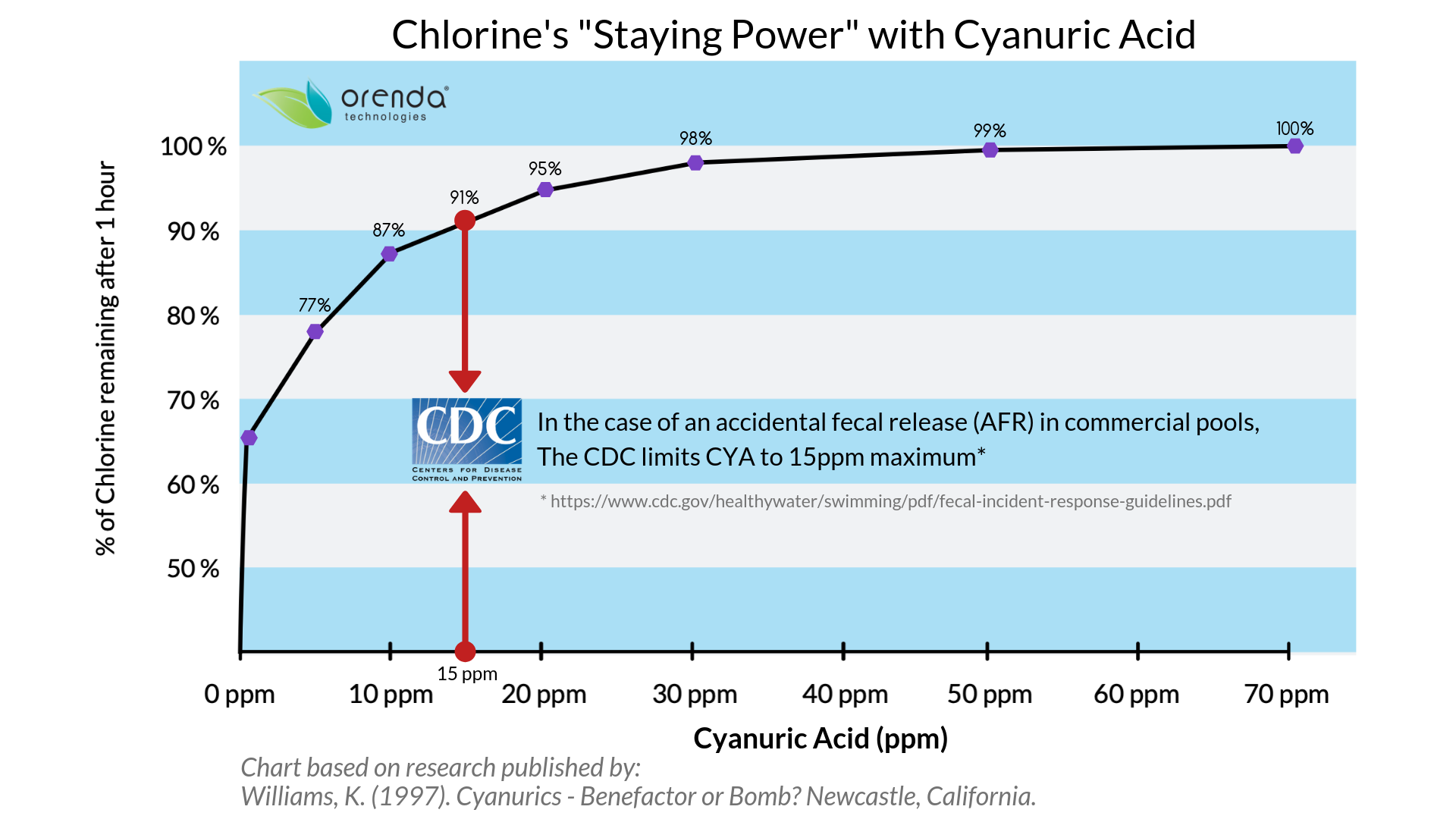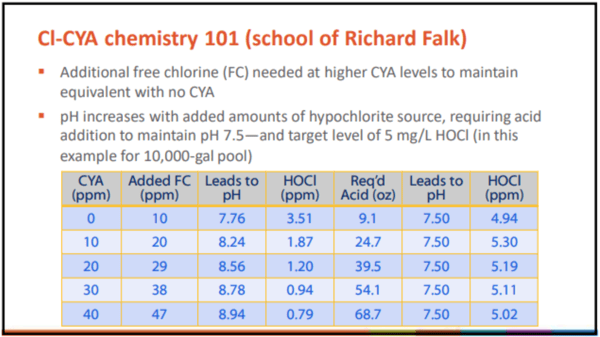What Does Cya Stand for in Pools
High levels of Cyanuric Acid (CYA) in pool water can cause issues. That's why Minimal CYA is Orenda's Fourth Pillar of Proactive Pool Care. And yet, we encounter many people that are hesitant to drain—or even dilute—their pool to reduce CYA levels. Perhaps there are valid reasons—costs, structural risks, labor, environmental concerns—for not draining high CYA pool water. That being said, draining and/or diluting water is still the most economical way to lower CYA levels in a pool. CYA, also known as "stabilizer" or "conditioner" in the pool industry, protects chlorine from degradation from the ultraviolet (UV) rays of the sun. CYA can be very beneficial up to a point, but becomes increasingly detrimental to the pool beyond that. Figure 1 below illustrates this: Figure 1: The relationship of chlorine's "staying power" and CYA Figure 1 shows us that roughly 20-30 ppm of CYA is enough to give us 95-98% protection from sunlight in the first hour, assuming this chart is accurate. This chart does not account for non-living organics or nitrogen compounds that chlorine still has to oxidize. Figure 1 just shows the relationship of sunlight, chlorine and CYA after one hour. As you can see, the benefits of CYA yield a diminishing return the higher you go. Granted, more CYA can give your chlorine more protection from sunlight for longer, but at what cost? For that, let's look at the work of the US Centers for Disease Control (CDC) and their research on CYA.1 The Committee that writes the Model Aquatic Health Code (CMAHC) released a 2016 update that indicates an upper limit of CYA in pools with a fecal incident . That upper CYA limit? Just 15 ppm. Yes, that may sound low, but there are practical reasons why. See Figure 2, showing how much more free available chlorine you need–with raised levels of CYA–to obtain similar levels of Hypochlorous Acid (HOCl): Figure 2: Chlorine-CYA Chemistry 101, by Richard Falk This chart basically shows that more CYA in your water means you need significantly more chlorine to have the same sanitization power. The CDC's recommended limit of 15ppm CYA is not necessarily a 'hard limit', but a practical one. Just look at how much chlorine (and acid to re-balance pH) is required to achieve the desired sanitation result. To keep water safe, sanitation is critical, and it needs to be practical. If you have read the Orenda Blog, you already know our opinion of CYA is that it is a double-edged sword. At low levels it provides tremendous benefits, but at high levels, big problems. It slows chlorine dramatically, which lowers ORP. The problem is not stabilization of chlorine, it's over-stabilization of chlorine. Here are three related articles: Regarding chlorine's ability to prevent algae, the Free Chlorine to Cyanuric Acid (FC:CYA) ratio is what matters, not just free chlorine. Referring back to Richard Falk, one of the committee members for the CMAHC, you need at least 7.5% of your CYA level in Free Chlorine to keep up with algae growth . Here are some examples: (100 ppm CYA) x (7.5%) = 7.5 ppm FC minimum needed to prevent algae (60 ppm CYA) x (7.5%) = 4.5 ppm FC minimum needed to prevent algae (30 ppm CYA) x (7.5%) = 2.25 FC minimum needed to prevent algae Usually, elevated levels of CYA are just a consequence of habits. Sometimes high CYA happens without realizing it . For example, trichlor adds CYA every time you use it. It seems like stabilized chlorine use is the main reason for high levels of CYA. As water evaporates, CYA stays behind, just like calcium and salt. If you are using a stabilized chlorine like trichlor or dichlor, CYA accumulates...fast. One pound of trichlor in 10,000 gallons of water will add 6 ppm of CYA. That adds up quickly. The purpose of this article is to inform people about CYA, its benefits and its drawbacks. We are writing this because we speak to pool professionals nationwide who either do not know about CYA's impact on chlorine efficacy, or do not realize how serious it is. We hope this article helps. As if CYA's impact on chlorine were not enough of a reason to keep its levels to a minimum, there is more. Another relatively misunderstood consequence of CYA is its impact on your water's overall balance. According to the Langelier Saturation Index (LSI) , CYA matters because it leads pool operators to believe they have more carbonate alkalinity than they really do. This is because the LSI formula requires a CYA correction against total alkalinity to find the carbonate alkalinity . It's complicated (but the Orenda App does all the math for you). All you need to know is the higher your CYA, the lower your LSI. And you might be surprised at just how impactful CYA is when using the Orenda App LSI calculator . What can you do if your CYA levels are already high? Can CYA levels be reduced in a pool? Yes, the most economical way to lower CYA is to partially drain and dilute the pool with fresh water. Consult a pool professional if you want to drain more than 1/3 of your water, because there are risks with hydrostatic pressure and other concerns. There are also some specialized filters that exist to capture CYA and remove it from water, such as reverse osmosis (RO). RO is far more costly, but it may be the best option for people in regions of the country that are unable to drain their pools. It really just comes down to cost and risk. Significant draining has risks and should only be done by a pool professional, so dilution over time is often the best option. The alternatives to draining your water are to 1) pay big money for filtration, or 2) try to manage the pool with high levels of CYA. Neither of those two options are as easy or affordable as replacing water with fresh water. The bottom line: keep CYA levels low enough to manage sanitation and maintain LSI balance. If your CYA is too high, draining and diluting is the most cost effective means to reduce CYA in your pool. 1 Falk, R.A.; Blatchley, E.R., III; Kuechler, T.C.; Meyer, E.M.; Pickens, S.R.; Suppes, L.M. Assessing the Impact of Cyanuric Acid on Bather's Risk of Gastrointestinal Illness at Swimming Pools. Water. 2019, 11, 1314. What is CYA, and why keep it to a minimum?

The CDC's Model Aquatic Health Code (MAHC)

How do CYA levels get so high?
CYA's negative impact on the LSI
How to reduce CYA in pools
What Does Cya Stand for in Pools
Source: https://blog.orendatech.com/how-to-reduce-cyanuric-acid-cya-in-a-swimming-pool
0 Response to "What Does Cya Stand for in Pools"
Post a Comment